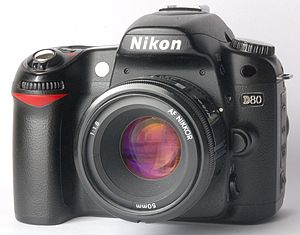 | |
| Overview | |
|---|---|
| Type | Digital single-lens reflex |
| Lens | |
| Lens | Interchangeable, Nikon F-mount |
| Sensor/medium | |
| Sensor | 23.6 mm × 15.8 mm Nikon DX format RGB CCD sensor, 1.5 × FOV crop |
| Maximum resolution | 3,872 × 2,592 (10.2 effective megapixels) |
| Film speed | 100–1600 in 1/2 or 1/3 EV steps, up to 3200 as boost |
| Recording medium | Secure Digital, SDHC compatible |
| Focusing | |
| Focus modes | Instant single-servo (AF-S); continuous-servo (AF-C); auto AF-S/AF-C selection (AF-A); manual (M) |
| Focus areas | 11-area AF system, Multi-CAM 1000 AF Sensor Module |
| Exposure/metering | |
| Exposure modes | Programmed Auto [P] with flexible program; Shutter-Priority Auto [S]; Aperture Priority Auto [A]; Manual [M] |
| Exposure metering | TTL 3D Color Matrix Metering II metering with a 420-pixel RGB sensor |
| Metering modes | 3D Color Matrix Metering II, Center-weighted and Spot |
| Flash | |
| Flash | Built in Pop-up, Guide number 13m at ISO 100, Standard ISO hotshoe, Compatible with the Nikon Creative Lighting System |
| Shutter | |
| Shutter | Electronically controlled vertical-travel focal-plane shutter |
| Shutter speed range | 30 s to 1/4000 s and Bulb, 1/200 s X-sync |
| Continuous shooting | 3 frame/s up to 100 JPEG or 6 RAW images |
| Viewfinder | |
| Viewfinder | Optical 0.94× Pentaprism |
| Image processing | |
| White balance | Auto, Incandescent, Fluorescent, Sunlight, Flash, Cloudy, Shade, Kelvin temperature, Preset |
| General | |
| LCD screen | 2.5-inch (64 mm) TFT LCD, 230,000 pixels |
| Battery | Nikon EN-EL3e Lithium-Ion battery |
| Optional battery packs | MB-D80 battery pack (with vertical shutter release) with one or two Nikon EN-EL3e or six AA batteries |
| Weight | Approx. 585 g (1.290 lb) without battery, memory card, body cap, or monitor cover |
| Made in | |
| Chronology | |
| Predecessor | Nikon D70S |
| Successor | Nikon D90 |
The Nikon D80 is a digital single-lens reflex camera model announced by Nikon on August 9, 2006.[1] The camera shipped the first week of September to US retailers. Considered by many[who?] to be a hybrid of design elements of the entry-level D50 and high-end D200 cameras, it occupied the same price bracket the Nikon D70 did at the time of its release. It was replaced by the Nikon D90 in August 2008.
- ^ "Outstanding performance, ease of operation, versatile personal control and exciting in-camera effects make digital SLR photography more rewarding for all" (Press release). Nikon Corporation. 2006-08-09. Archived from the original on 2006-08-14.